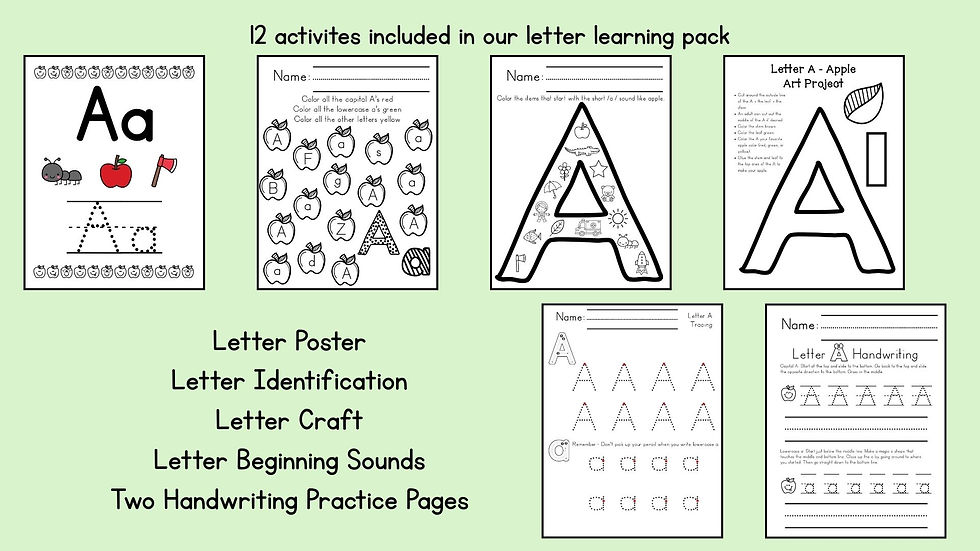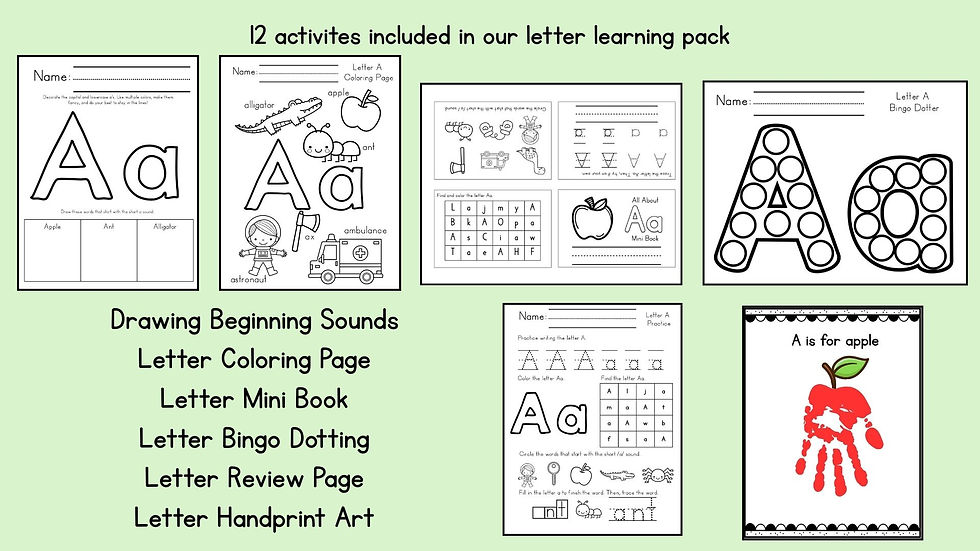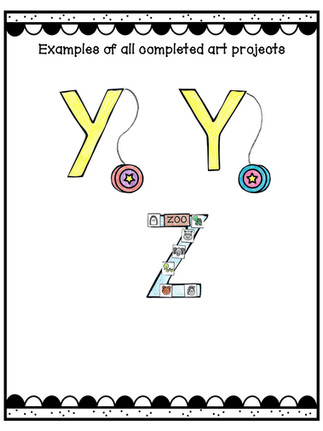Building Blocks of Literacy: Learning Letters in Preschool
- Mrs. Briana & Mrs. Christine

- Sep 16
- 7 min read
Updated: Oct 14
In preschool, the foundation for reading and writing is built. One of the best ways to introduce children to the alphabet and its sounds is by focusing on one letter each week. This method gives kids the time and space to absorb each letter's unique features and sounds while making learning fun and interactive. If you're teaching preschoolers, focusing on one letter per week can help your young learners gain confidence as they develop important early literacy skills. In our 9 years of teaching our kindergarten prep program, our emphasis on letters and sounds has remained our primary focus. We know that as students enter kindergarten the speed at which they are expected to absorb and master letters and sounds is incredibly fast. Often times. kindergarteners are learning a minimum of two letters a week. If we can give them a strong foundation in preschool and they can enter kindergarten confident in identifying letters, knowing the letter sounds and writing letters they will inevitably be set up for more success in kindergarten.
Here’s a guide to making the "one letter a week" approach a success in your preschool classroom:

Why Focus on One Letter Per Week?
Repetition Reinforces Learning
By spending a week on each letter, children get plenty of repetition, which helps them remember the letter’s name, sound, and written form. This repeated exposure allows them to feel more comfortable with each letter before moving on to the next.
Mastering One Thing at a Time
Young children often thrive when they can focus on mastering one concept before adding another. By focusing on just one letter per week, you help them make connections between the letter and its sound, all while giving them the time to explore its shape, writing, and phonetic sound.
Engaging and Fun Activities
Focusing on a single letter allows you to create fun, hands-on activities and games centered around that letter. This keeps kids engaged and excited about learning!
Benefits of One Letter a Week Approach
Mastery: This method allows children to truly master each letter one at a time. They’ll understand not just how to recognize it but how it sounds, how it’s written, and how it fits into words.
Engagement: Focusing on one letter each week keeps the classroom energized and focused. It gives you the flexibility to plan creative lessons around that one letter, incorporating art, movement, and music to keep things exciting.
Building Confidence: When children master a letter, they gain confidence in their abilities. This foundation will make them feel more prepared when they begin reading and writing.
What Order do we Teach the Letters?
This is the order we typically teach letters. We usually start letters on our third week of the school year. We give ourselves time to get the kids comfortable with the routine of school before jumping into learning letters.
We DO NOT teach letter in the order of the alphabet!
We introduce letters based on their frequency of use in words. We also like to introduce all 5 vowel sound before the second semester so we can start introducing the idea of CVC words for the students that are ready. Some of our letters are planned around the theme of the week. Here is the order we typically teach letters:
C A S N B F U O H E T I L G M P D Y X V K Z W R J Q
This is by no means the "right" way and use your teacher judgement as you plan and teach letters. We always teach letter C first because the Magic C shape is used for so many letters and numbers and is a foundational fine-motor skill. Go check out our Clever Letter C Blog to learn more!
Setting Up Your Week
For each letter, your week can be broken down into daily activities, creating a rhythm and consistency that helps the child’s brain absorb the letter more deeply. Preschool programs greatly vary in the number of days and hours depending on the program. We will share the activities and skills we do each week with each new letter. You can organize them into your week as it best fits your schedule.
Introduction to the Letter
Introduce the Letter’s Name and Sound
Start the day by introducing the letter. For example, if the letter of the week is "S," introduce the sound it makes (the /s/ sound as in "snake"). Show them both the uppercase and lowercase version of the letter. We typically do this during calendar time.
Letter Song
Kids love songs! Use a simple song or rhyme about the letter to reinforce its name and sound. We sing the same letter song for each letter:
Letter B says /b/
Letter B says /b/
Every letter makes a sound
Letter B says /b/
Exploring Letter Sounds
Letter Sound Examples
Show real-life objects that start with the letter of the week. For example, for "S," you might show a snake, sun, or spoon. Have the children say the name of each object and emphasize the beginning sound.
Interactive Sound Games
Play a sound game where children can match objects to the sound. For example, you can hold up pictures of items like "sock," "star," and "shoe" and have the children give you a thumbs up and thumbs down depending on if they hear the /s/ sound at the beginning.
Beginning Sound Bingo Dotter Activity
We have created the following beginning sound activity. We talk about each picture, say it several times and if it has the correct letter sounds, we let the kids put a bingo dot on it.

When these dry, they are a great page to keep and make a book of because they help review words that start with the letter sounds.

Letter Beginning Sounds Coloring Page

Letter Art
Create an art project using the letter. See these examples we use. We have a full set of Letter Art Projects available. Another Art project idea is make handprint art for each letter.
Click Below to get ALL 26 Letter Art Projects shared above:
Letter Recognition in Stories
Read Books with the Letter
Read a book that features a lot of words beginning with your letter. For example, read a book about "S" like "The Snowy Day" by Ezra Jack Keats or "A Silly Soup" for younger kids. Highlight words that begin with the target letter, pointing them out as you read.
Create a Letter/Sound Wall
On a bulletin board or a wall, create a display with images or cut-outs of objects that start with the letter of the week. This can become a valuable visual tool for your class.
Letter Recognition Coloring Page
Search and Find both capital and lowercase letters.

Letter Writing
Fine Motor Practice
Help the children practice writing the letter with different materials. Provide paper and markers, or even allow them to form the letter in sand or with playdough. Making it a sensory experience adds an extra layer of engagement.
Explicitly teach the correct letter formation
We have videos on our YouTube Channel where we teach each letter. We prefer the Handwriting Without Tears method. We like to demonstrate the correct way to write the capital and lowercase letters.
Play the Game: Keep it or Lose it!
Watch this short video of a game we like to play when we teach letter handwriting. We want our students to be able to remember the correct formation and identify differences and mistakes when that letter is formed incorrectly.
Worksheet Practice
It is important to allow preschoolers time to use paper and pencil to practice handwriting and build fine motor skills.
Letter Review and Reinforcement
Letter Scavenger Hunt
Searching for the letter in a book or around the classroom.
Letter Mini Book
Review of handwriting, beginning sounds and identifying capital and lowercase letters.

Front of the mini book 
Inside of the mini book 
Back of mini book 
Letter Review and Practice worksheet
Activities for the Whole Week
Here are some additional activity ideas you can sprinkle throughout the week:
Letter Song
Sing the Letter of the Week song every day - multiple times!
Letter-Themed Snack
If possible, create a letter-themed snack. For example, if you're focusing on "B," have “banana bites” or “blueberries.” It’s a great way to make learning multi-sensory.
Letter You-Tube Videos!
We have videos for each letter including our ALL ABOUT THE LETTER videos. We also love Jack Hartmann!
Letter Resources!
Everything we have shared is included in our Learning Letter Packets on TPT!
We have one for every Letter of the Alphabet!
All of our letter packs will be fully updated and new resources are being added by end of September 2025!
Purchase the Letter Bundle to get all 26 letter and all the resources!
Here is a FREE Letter A Learning Pack Link!


All of our letter pack have the same resources!
Letter Review
Practice, Practice, Practice
Remember your preschoolers will need repeated exposure to the letter after they learn it. We always add the letters we have learned in a set of flashcards and review them every day in calendar. Continue to identify the letters your students have learned and practice the letter sound and handwriting in centers and small groups. The more times they see it, say it and write it - the more concrete it will become.
Conclusion: Enjoy the Process
The key to teaching letters and sounds in preschool is making it a fun, engaging, and stress-free process. Focusing on one letter a week gives children the time and space to fully immerse themselves in each letter’s identity, and helps build a strong foundation for literacy.
As you guide your students through the alphabet, remember to celebrate each small achievement—whether it’s recognizing a letter in a book, saying its sound, or writing it for the first time. And most importantly, make sure to enjoy the journey of learning together!
Happy teaching! 🌟
























Comments